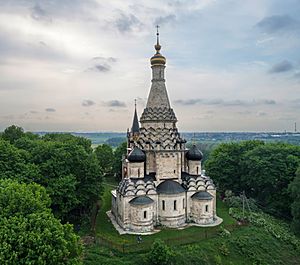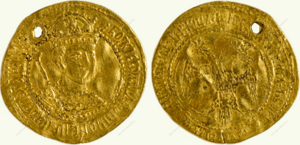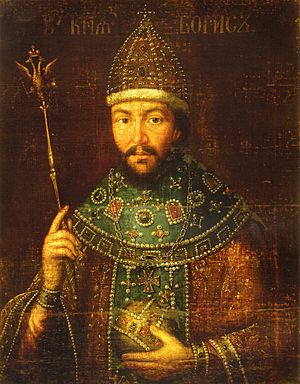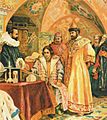Boris Godunov facts for kids
Quick facts for kids Boris Godunov |
|||||
|---|---|---|---|---|---|
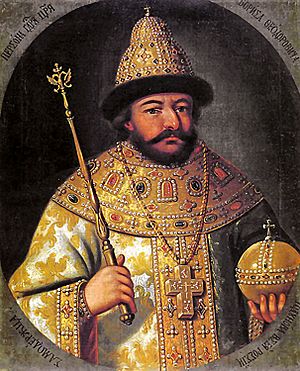 |
|||||
| Tsar of all Russia | |||||
| Reign | 21 February 1598 – 23 April [O.S. 13 April] 1605 | ||||
| Coronation | 1 September 1598 | ||||
| Predecessor | Irina Godunova (disputed) | ||||
| Successor | Feodor II | ||||
| Born | 12 August [O.S. 2 August] 1552 Vyazma, Russia |
||||
| Died | 23 April [O.S. 13 April] 1605 (aged 52) Moscow, Russia |
||||
| Burial | Godunov Mausoleum in front of the Cathedral of the Assumption at the Trinity Lavra of St. Sergius | ||||
| Spouse | Maria Skuratova-Belskaya | ||||
| Issue | Feodor II of Russia Xenia Godunova |
||||
|
|||||
| Dynasty | Godunov | ||||
| Religion | Russian Orthodox | ||||
Boris Feodorovich Godunov (Russian: Борис Фёдорович Годунов; 12 August 1552 – 23 April 1605) was a powerful figure in Russian history. He served as the de facto (meaning "in practice" or "unofficial") regent of Russia from 1585 to 1598. A regent is someone who rules a country when the official ruler is too young or unable to govern. After this, Boris became the tsar (the emperor of Russia) in 1598 and ruled until 1605. He took over after the death of Feodor I, who was the last ruler from the old Rurik dynasty. After Boris Godunov's reign, Russia faced a very difficult period known as the Time of Troubles.
Contents
Early Life and Rise to Power
Boris Godunov came from an old Russian family. His career began at the court of Ivan the Terrible, a famous Russian ruler. In 1570, Boris was part of a military campaign. The next year, he became an oprichnik. These were members of Ivan's special guard and secret police.
Boris strengthened his position at court by marrying Maria Grigorievna Skuratova-Belskaya. She was the daughter of Malyuta Skuratov-Belskiy, who led the oprichniks.
In 1580, Tsar Ivan the Terrible chose Boris Godunov's sister, Irina Godunova, to marry his second son, Feodor Ivanovich. This marriage was a huge step up for Boris. Because of it, he was promoted to the rank of boyar, a high-ranking noble. In 1581, Boris was present when Tsar Ivan IV accidentally injured his eldest son, Ivan, who later died. Boris tried to help the prince.
Becoming Regent of Russia
When Ivan the Terrible died in 1584, he named a special council to guide his son and successor, Feodor I. Feodor was not strong in mind or body. He preferred to focus on religion rather than ruling. Boris Godunov was a key member of this council.
Ivan also had a young son named Dmitry Ivanovich. Dmitry and his mother were sent away from Moscow to a town called Uglich. In 1591, Dmitry died there at the age of ten. The circumstances of his death were suspicious.
When news of Dmitry's death spread, the people of Uglich were very upset. They believed he had been murdered, possibly by Boris Godunov's agents. An official group, led by Vasili Shuiski, investigated Dmitry's death. They announced that Dmitry had accidentally cut himself during an epileptic seizure. Dmitry's mother believed her son was murdered. Boris Godunov's involvement was never proven.
At the coronation of Feodor I in 1584, Boris received many honors and riches. He became the second most powerful person in the regency council. When the Tsar's uncle, Nikita Romanovich, died in 1586, Boris became the most powerful regent.
Some other nobles tried to reduce Boris's power. They tried to get the Tsar to divorce Boris's sister, Irina, because she had no children. But their plan failed. The nobles involved were punished. After this, Boris was truly in charge of Russia. He even communicated with foreign leaders as an equal.
Boris Godunov's Policies as Regent
Boris Godunov's foreign policy was generally peaceful and smart. In 1595, he got back some towns from Sweden that Russia had lost earlier. Five years before that, he stopped a Tatar attack on Moscow. For this, he received a special title. He also supported a group against the Ottoman Empire in the Crimean Peninsula.
Boris encouraged English merchants to trade with Russia. He even removed some taxes for them. He built new towns and forts along Russia's borders. These included Samara, Saratov, Voronezh, and Tsaritsyn. He also helped settle Siberia with many new communities, like Tobolsk.
During his rule, the Russian Orthodox Church became a patriarchate. This meant it was equal to the ancient Eastern churches and free from the control of the Patriarch of Constantinople. This made Tsar Feodor happy, as he cared a lot about church matters.
One of Boris Godunov's most important changes was a decree in 1597. It stopped peasants from moving from one landowner to another. Before this, they could move freely once a year. This new rule tied them to the land. It was meant to help the government collect taxes, but it led to the harsh system of serfdom in Russia.
Becoming Tsar and His Reign
Tsar Feodor I died without children on 7 January 1598. With no direct heir, Boris Godunov was seen as the best person to lead Russia. The head of the church, Patriarch Job of Moscow, believed Boris was the only one who could handle the country's problems. Boris agreed to become tsar only if the Zemsky Sobor (a national assembly) elected him. On 21 February, the assembly chose him unanimously. On 1 September, he was officially crowned tsar.
In the early years of his rule, Boris was popular and successful. He understood that Russia needed to catch up with the rest of Europe in terms of knowledge and progress. He worked hard to bring about changes in education and society. He was the first tsar to bring many foreign teachers to Russia. He also sent young Russians to study in other countries. He even allowed Lutheran churches to be built in Russia.
Boris tried to gain access to the Baltic Sea through diplomacy. He also built good relationships with Scandinavian countries. He hoped to arrange a marriage for his children with a foreign royal family. However, he turned down an offer in 1600 to join Russia with the Polish–Lithuanian Commonwealth.
Boris Godunov died on 23 April 1605, after a long illness. He left behind one son, Feodor II, who became the next tsar. However, Feodor II ruled for less than a month. He and Boris's wife were murdered by enemies of the Godunov family in Moscow in June 1605.
Boris also had a daughter, Xenia. She was supposed to marry John, Prince of Schleswig-Holstein, but he died before their wedding. Xenia later became a nun. Boris, his wife, and their children are buried together in a special tomb near the entrance of the Assumption Cathedral at the Trinity Lavra of St. Sergius.
Boris Godunov in Arts and Media
Boris Godunov's life has inspired many famous works of art.
- The famous Russian writer Alexander Pushkin wrote a play called Boris Godunov (1831).
- The composer Modest Mussorgsky turned Pushkin's play into a famous opera also called Boris Godunov.
- Another composer, Sergei Prokofiev, wrote music for Pushkin's play.
- In 1997, a very old opera from 1710 about Boris's reign was found. It was written by a German composer named Johann Mattheson. This opera was performed for the first time in 2005.
Boris Godunov has also appeared in modern media:
- He was featured in radio plays on BBC Radio 4 as part of a series called Tsar.
- A Russian TV show called Godunov (TV series) (2018) tells the story of Boris Godunov's life.
- The cartoon character Boris Badenov from The Rocky and Bullwinkle Show has a name that sounds similar to Godunov's name.
Images for kids
-
Presentation of the Virgin in the Temple and the Virgin of the Burning Bush, Walters Art Museum
See also
 In Spanish: Borís Godunov para niños
In Spanish: Borís Godunov para niños
- Bibliography of Russian history (1223–1613)
- Tsars of Russia family tree



